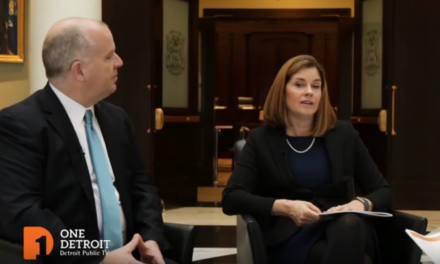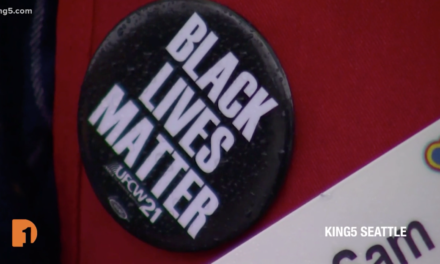Henry Ford College and Wayne State University have teamed up to help clear some of the existing hurdles higher education students face when seeking a four-year degree. A new initiative, titled “Henry Ford College Learn4ward and Wayne State Transfer Pathways,” will provide Henry Ford College students, once they’ve completed their associate degree, guaranteed admission and a full credit transfer to Wayne State University as a junior to earn a bachelor’s degree.
Students must earn a cumulative 2.5 or higher GPA on a minimum of 60 credits, as well as earn their associate degree, to be eligible for the transfer. The new program also supports Michigan’s 60×30 initiative to increase the number residents who have a four-year degree or professional credentials to 60% by 2030.
One Detroit Producer and Future of Work host Will Glover sat down with Henry Ford College President Russell Kavalhuna about the impact the program will have on the future of education and work in Michigan. They talk about how the program could make Michigan’s workforce more competitive, the renewed focus on higher education across the state, how the program helps Michigan’s 60×30 goal, and where Southeast Michigan residents can learn more.
Full Transcript:
Will Glover, @WillofMichigan, Producer, One Detroit: Let’s just start with the very basics. What is it? What is the overall goal of the program?
Russ Kavalhuna, President, Henry Ford College: The overall goal of the program is Michigan needs to get more competitive in many respects. But one respect is those citizens who have a four-year degree. And that’s because, across the country, states are starting to count how many heads they have in their state as a percentage with four-year degrees. Now, Michigan happened to start this race behind. We were in the bottom third. Now we’re making up ground. But the truth is, at least on this metric, Michigan has now decided across bipartisan divides that we need to have more four-year degrees.
Now, the role we play in that is to help a lot of people who are contemplating whether they should or can attend college. We are an open-access institution that has very few barriers. We’re in your neighborhood, our cost is low, our programs are wide. And when you get to our college, you get your way through at least two years of college. And then, if we’re going to start making ground in this race against other states for four-year degrees, we have to see our students on to the four-year degree institutions.
And so, we lie at that intersection between four-year degree institutions and ours, and there were barriers there. So, we went about trying to attack those barriers. And we’re pretty excited that this almost eliminates every barrier that a student at HFC would see as they move to Wayne State University or other four-year degree institutions.
Will Glover: Why does it feel like it’s taken so long for institutions to get to this point where you guys are, where you’re trying to make this a streamlined process? Is it the motivating factor of what the state needs, what the economy and employers here need?
Russ Kavalhuna: I can’t speak to why it hasn’t happened before. I can speak to how it has started to happen, and it’s become the focus that we have on students. Historically, higher education has not been as focused on what helps students, and right now that is the future of higher education. So, we’ve spent a lot of time trying to understand the hurdles that students face that stop them from getting to that college credential that we need to have a higher percentage of our citizens having. And one of them is the things you just mentioned.
Our students will work hard, work well in the classroom, work at home, taking care of family. A lot of our students work really hard to get these 60 credits in their associate degree, and then they face more hurdles to move to four-year degree institutions. And some of those hurdles were, How many credits will I take with me? I spent a lot of time and money on those credits. Will I have to ask for permission? And what if they say no? Because a lot of my students are first-generation either Americans or college students like my dad was. And it’s a serious question, will they say no? And no one wants to be told no.
So, we went right at those two hurdles after hearing our students say, “These are the hurdles that we have moving from Henry Ford College to Wayne State University.” And with this agreement, if they get through Henry Ford College and show academic success, they don’t have to worry about being told no when they ask for admission at Wayne State. And if they collect 60 credits, they don’t have to worry about whether those 60 credits travel with them. And that is really focusing on students. And that is where we’re going to make up ground on this 60 by 30, getting 60% of a Michigander population to a post-secondary credential.
Will Glover: Do you think that that’s going to be the case? Because sometimes it seems like an obvious solution. But I’m sure there are other considerations that other higher institutions might have when it comes to maybe the quality of education from one institution to another, whether or not they’re accepting students that might not be able to fit, or make it, or actually graduate. Do you think that what you guys are doing is going to catch on?
Russ Kavalhuna: Let me just be blunt, I talk to students a lot, both at universities and community colleges and there is historically an idea that community colleges were for a lesser student, and that couldn’t be further from the truth. That’s my experience here, that it’s not the truth and the experience of my parents who are community college graduates. Community college students have an opportunity to be just as good as anyone else, but they’re using the access portal that we have, which has a low barrier for cost and a low barrier for geographic distance from your home.
And I know that because when I talked to President Wilson, I said, “Look at the students that we bring you. They perform as well or better than the students that started with you at the beginning of university.” And President Wilson, like any other very sharp leader, knew that to be true, checked it to be true. But still, we said, “We don’t have any interest to send you students who are going to come to your institution having left and report to college and then not be successful with you. And so, you tell us, partner at Wayne State University and any other institution that we would gain this kind of agreement with, you tell us what we can do to show that these students are ready for your institution.”
And Wayne State decided to say, “We want you to bring us students with a 2.5 grade point average at Henry Ford College.” Now, it was helpful to show Wayne State the data that when we bring students because we do 300 to 400 a year, when those students come over to them with 2.5 or higher, they are successful. And in many instances more than the students who started at Wayne State University. So, that was a quick way for both partners to feel like it was going to be successful. And that makes me believe, to answer to your ultimate question, that this can catch on.
Will Glover: Is there anything that you would like to share with people that would be particularly useful? Or how they might get in touch and get put into this pipeline and how they can get a pathway forward for themselves?
Russ Kavalhuna: If you or anyone in your sphere is contemplating whether college is for them, reach out to me. I have publicly committed, anyone who contacts me by email will get a personal response. It is statistically proven that if you invest in yourself in higher education, you will be healthier, you’ll be wealthier, and you’ll be happier.
Stay Connected:
Subscribe to One Detroit’s YouTube Channel & Don’t miss One Detroit Mondays and Thursdays at 7:30 p.m. on Detroit Public TV, WTVS-Channel 56.
Catch the daily conversations on our website, Facebook, Twitter @DPTVOneDetroit, and Instagram @One.Detroit
View Past Episodes >
Watch One Detroit every Monday and Thursday at 7:30 p.m. ET on Detroit Public TV on Detroit Public TV, WTVS-Channel 56.




